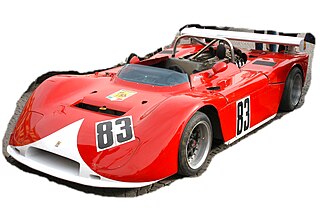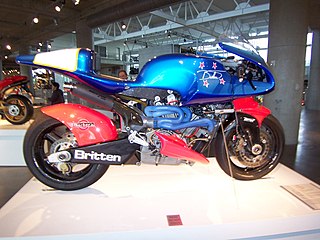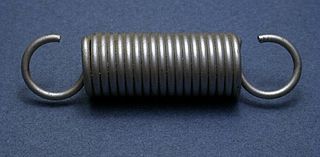
The Lotus 32 was a Formula 2 racing car built by Team Lotus in 1964. It was developed from the Lotus 27 Formula Junior model. Twelve cars were produced, four of which were run by Ron Harris Team Lotus, whose drivers included Jim Clark and Mike Spence. Spence won the 1964 Autocar British Formula 2 Championship while Clark was fourth in the Trophées de France Championship.
Lloyd Cars Ltd was a British motor manufacturer, founded by Roland Lloyd (1904–65), son of a garage owner, and based in Patrick Street, Grimsby, Lincolnshire, England between 1936 and 1951. Two models were made, separated by World War II; the company was unusual for a small manufacturer in making nearly all components in-house. After car production ceased the company continued in general engineering until 1983. During World War II the company made components for Rolls-Royce Merlin aircraft engines.

Suzuki GSX-R750 is a family of 750 cc sports motorcycles from Suzuki's GSX-R series of motorcycles. Looking like a Suzuki Endurance racer, it can be considered to be the first affordable, modern racer-replica suitable for road use. It was introduced at the Cologne Motorcycle Show in October 1984.

The Bowin P3 is a monocoque racing car that was produced in 1968 by Bowin. The P3 was designed for the Australian National Formula and the Australian 1½ Litre Formula. After the capacity limit for Australian Formula 2 was increased from 1100cc to 1600cc at the beginning of 1969, the P3 found a new home in that class. The car was designed by John Joyce, founder of Bowin and assisted by Ray Parson, better known as a mechanic.

The Bowin P8 is a Formula 5000 and Formula 2 racing car, which was designed and built between 1972 and 1974 by Bowin.
The Chevrolet Engineering Research Vehicle (CERV) is a series of Chevrolet experimental cars. Chevrolet Staff engineer, designer, and race car driver Zora Arkus-Duntov started development of the CERV I in 1959, and began work on the CERV II in 1963. Chevrolet chief engineer Don Runkle and Lotus' Tony Rudd discussed creating a new show car to demonstrate their engineering expertise in 1985; It would become the CERV III. Corvette chief engineer Dave Hill unveiled the CERV IV in 1993, a test vehicle for the 1997 C5 Corvette.

The Ducati 749 is a 90° V-twin Desmodromic valve actuated engine sport bike built by Ducati Motor Holding between 2003 and 2006. Designed by Pierre Terblanche, the 749 was available as the 749, 749 Dark, 749S, and 749R. It shared many of its parts with the 999, with the exception of a slightly smaller 180/55 profile rear tire, smaller cylinders, and different cylinder heads, giving it a smaller displacement of 748 cc. This smaller engine is higher revving and produces a lower peak horsepower than the larger engine used in the 999. The 749S model, like the 999, incorporates features rarely found on production motorcycles, including adjustable rake and five-position adjustable rearset mounts.
Motorcycle components and systems for a motorcycle are engineered, manufactured, and assembled in order to produce motorcycle models with the desired performance, aesthetics, and cost. The key components of modern motorcycles are presented below.

The Vincent Rapide is a line of standard motorcycles designed and built by the Vincent HRD motorcycle company at their works in Great North Road, Stevenage, Hertfordshire, England. The model debuted in 1936 and was built until 1939. Production resumed in 1946 and ended in 1955. Four major versions were built, labelled Series A through D.

The Bandini 1000 GT is a road car produced in 1963 by Bandini Cars of Forlì, Italy.

The Bandini 1000 is a race car, built in 1966 by Bandini Cars Forlì.

The Bandini 1300 was a racing car built in 1980 by Bandini Cars in Forlì, Italy.

The Aprilia Tuono is a naked motorcycle manufactured by Aprilia from 2002. It is based on the Aprilia RSV Mille. Its successor, the Aprilia RSV1000R superbike shares its engine, gearbox, frame and, partly, its suspension. The Tuono was succeeded by the Aprilia Tuono V4 R for model year 2011, though the V2 model continued in production into the 2011 model year.

The Britten V1000 is a handbuilt race motorcycle designed and built by John Britten and a group of friends in Christchurch, New Zealand during the early 1990s. The bike went on to win the Battle of the Twins in Daytona International Speedway's Daytona Bike Week festivities in the United States and set several world speed records.

The Vauxhall 20-60 is a four or five-seater saloon, limousine, tourer or coupé-cabriolet manufactured by Vauxhall of Luton. It was announced on 28 September 1927 with a six-cylinder engine and a four-speed gearbox. A cautious move downmarket. "The first time any six-cylinder Vauxhall has been sold under £1000!" "British & Vauxhall". The initial 2.7-litre engine was enlarged to 3-litres after twelve months.
The Audi R8 LMS Cup is a one-make sports car racing series by Audi based in Asia. Audi R8 LMS Cup cars based on the Audi R8 LMS(GT3).

Their new Daimler 22 horsepower full-size luxury car was first displayed by Daimler in April 1902 at The Automobile Club’s Exhibition in London's Agricultural Hall. Daimler had elected to drop their multiple old low powered designs and restrict themselves to this 22 horsepower and a pair of 9 or 12 horsepower cars to the same design as the 22 but more lightly constructed. The King’s not quite finished new Daimler 22 was reported to be the chief attraction of the show.

The Honda C92 Benly is a 125 cc (7.6 cu in) parallel-twin motorcycle made by Honda from 1959 through 1965. Running concurrently were the CB92 Sports and the slightly larger C95 150 cc (9.2 cu in), called the CA92 and CA95 in the US. These twins took their styling and design cues from the larger-displacement Honda C71, C76, C72, C77 Dream series.
The Hillman Straight Eight and its successor the Hillman Vortic were moderate priced mid-sized 20 tax-horsepower executive cars made by Hillman from 1929 to 1930. The lowest priced eight-cylinder car on the market the car was scarcely in full production when sales were hit by the onset of the Great Depression.



























